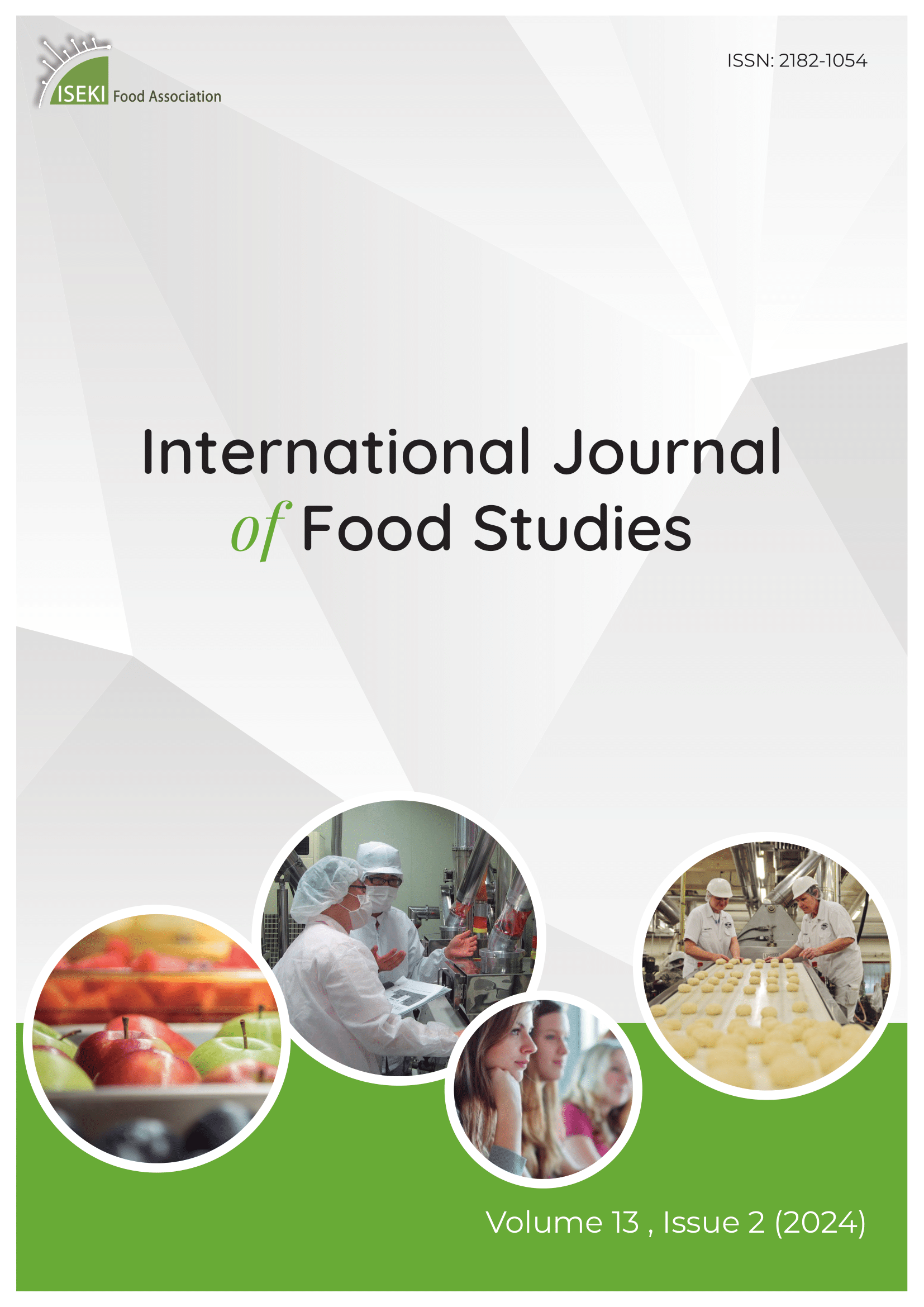Current issue

Volume 13, Issue 2, 2024
Online ISSN: 2182-1054
Volume 13 , Issue 2, (2024)
Published: 18.10.2024.
Open Access
All issues
Contents
17.04.2020.
Original scientific paper
The effect of gamma irradiation on the essential oils and antioxidants in dried thyme
This research was undertaken to investigate the effect of gamma rays at dose rates of 5.0, 10.0 and 15.0 kGy on the chemical composition of essential oils, total antioxidants, total flavonoids and total phenols, as well as the antioxidant activity and the thiobarbituric acid (TBA) and the free radical-scavenging activity (DPPH) of thyme. Radiation processing increased the total phenols, total flavonoids and total antioxidants of thyme, and moderate changes were detected at doses of 5 and 10 kGy for the essential oils. Thymol was sensitive to irradiation, especially at 15.0 kGy doses. In addition, the evaluation of antioxidant activity using DPPH radical-scavenging activity indicated some decreases of antioxidant activity in irradiated samples, while thyme exposed to doses of 10 and 15 kGy exhibited a significant increase in TBA values. The irradiation process can facilitate the utilisation of thyme as a preservative ingredient in the food and pharmaceutical industry.
Amal N. Al-Kuraieef, Amal Alshawi
18.04.2020.
Original scientific paper
Bacterial diversity, biogenic amines and lipids oxidation in traditional dried anchovy (Encrasicholina punctifer) during ambient storage
This study aimed to elucidate the effect of ambient storage (23±2°C, 68% RH) on the bacterial load and diversity, biogenic amines and lipids oxidation in traditional dried anchovy (E. punctifer) in order to evaluate its safety, quality and stability during 12 weeks of storage. Total aerobic bacteria (TAB), Staphylococcus aureus, Enterobacteriaceae (ENT), histidine decarboxylating bacteria (HDB), lysine decarboxylating bacteria (LDB) and ornithine decarboxylating bacteria (ODB) were enumerated and identified by conventional, VITEK 2 compact and sequencing of 16S rRNA gene methods. Histamine, cadaverine and putrescine contents were determined by high performance liquid chromatography. Lipid oxidation was evaluated by peroxide value (PV). Total aerobic bacteria, S. aureus, ENT, HDB, LDB and ODB initial counts of log10 4.9 ± 0.85, 3.7 ± 0.57, 4.2 ± 0.05, 3.7 ± 0.72, 3.9 ± 0.40 and 4.1 ± 0.24 CFU/g respectively did not significantly change (p > 0.05) during 12 weeks of storage. A high bacterial diversity of 27 species belonging to 20 genera was found, with the dominance of S. aureus, Acinetobacter lwoffii and S. warneri and the first incidence of Psychrobacter celer, Desemzia incerta, Granulicatella elegans and Bhargavaea indica in dried fish. Initial histamine, cadaverine and putrescine contents and PV of 5.2 ± 4.3, 8.5 ± 1.9 and 5.8 ± 0.6 mg/100g and 0.19 ± 0.02 meq/kg respectively did not significantly change (p > 0.05) during 12 weeks of storage. This study found that ambient storage at 23±2°C, 68% RH for 12 weeks did not affect the bacterial load, biogenic amines and lipids, and that the dried anchovy remained microbiologically safe and of good quality.
Ismail Al Bulushi, Nejib Guizani, Mutamed Ayyash, Mohammed Al Za'abi, Aisha Abushelaibi, Hilton C. Deeth, Zahra Al Kharousi, Fathiya Al Hamadani, Salha Al Maskari, Jamila Alkalbani
18.04.2020.
Original scientific paper
The fortification of biscuits with coriander leaf powder and its effect on physico-chemical, antioxidant, nutritional and organoleptic characteristics
The aim of this study was to examine the effects of coriander powder substitutions at various proportions in biscuits. The coriander leaf powder (CLP) was rich in essential minerals like calcium (2805.46 mg/100 g), iron (42.1 mg/100 g) and phosphorous (44.36 mg/100g). The scavenging activity of CLP was 93.34% and the total phenolic content was found to be 40.43 μg/ ml GAE. The biscuits were prepared using 10, 20 and 30% CLP and were baked at 180 °C for 17 minutes. Biscuits were evaluated for their nutritional composition, antioxidant activities, phenolic content, texture, sensory quality and shelf life over 21 days. The macronutrients, antioxidant activities, phenolic content and hardness increased with increasing concentrations of coriander powder. According to the overall acceptability scores from sensory evaluation, 10% and 20% CLP supplemented biscuits were more acceptable than 30% CLP supplemented biscuits.
Deepali Mohite, Roji Waghmare
18.04.2020.
Original scientific paper
Flax seeds and finger millet enriched functional rusk
Bakery products are generally made up of refined wheat flour that may be deficient in both fibre and essential fatty acids. In this study α-linolenic acid and fibre enriched rusk using flax seeds and finger millet were developed. The proportions of finger millet, flax seed and wheat flours were optimized using Response Surface Methodology (RSM). On the basis of fibre and ALA content and baking quality characteristics of rusk 13.13%, 6.0% and 80.6% of finger millet, flax seed and wheat flours, respectively was finalized. The developed rusk contained 4.81% fibre and 1.36% α-linolenic acid. Wet and dry gluten content, SDS sedimentation, falling number, dough raising capacity of yeast and baking time of mixed flour of these components were statistically (p>0.05) similar to that of wheat flour (control). However, higher loaf weight and lower loaf height was observed in mixed flour rusk in comparison to control rusk. α-linolenic acid and fibres enriched rusk were developed with similar quality parameters and improved functional properties.
Amit Lohan, Ravinder Kaushik, Vikas Bansal, Kamal Gandhi
18.04.2020.
Original scientific paper
Effects of drying temperature on quality parameters of Thai fermented fish dip (Jaew Bong)
Fermented fish dip is a popular condiment in Thailand and the Lao People’s Democratic Republic. Thai fermented fish dip (TFFD), can be dried to increase its shelf life and ease of transportation. Dried TFFD can be rehydrated to return the powder to its original, paste-like form. Pre-cooked TFFD paste was dried at three different temperatures (40, 60, and 80 ºC). Total plate count, yeast and mold count, CIE colour values (L*, a*, and b*),non-enzymatic browning, and sensory scores of the resulting powders were determined. The CIE colour values and sensory scores were alsoanalysed for rehydrated TFFD. Increasing the drying temperature did not affect the total plate count or yeast and mold count. When dried at 80 ºC, the L* value of TFFD powder was reduced, although the a* and b* values were unaffected compared with lower temperatures. All CIE colour values of rehydrated TFFD decreased as drying temperature increased. Drying temperature did not affect the sensory scores of dried TFFD powder. However, rehydrated samples that had been dried at 80 ºC had significantly lower sensory colour scores than those dried at 40 or 60 ºC. Overall preference rankings of dried and rehydrated TFFD dried at 40 and 60 °C were better than for those dried at 80 °C. Due to an undesirable colour change in the rehydrated product, 80 ºC was deemed to be an unsuitable temperature for drying TFFD paste. In conclusion, both 40 and 60 ºC are appropriate temperatures for drying the product.
Pongdanai Duangsai, Somsamorn Gawborisut
01.12.2019.
Professional paper
Evaluation of growth and cereulide production by Bacillus cereus isolated from cooked rice
Conditions influencing Bacillus cereus growth and cereulide production, such as temperature and pH, were evaluated at varying incubation periods. The growth and cereulide production at different temperatures and pH values ranging from 10 to 40 ºC and 5.0 to 8.5, respectively showed that the temperature from 20 to 30 ºC and at pH from 6.0 to 7.0 gave the optimum growth and cereulide production by B. cereus SA105. pH below 6.0 resulted in reduced growth and cereulide production. Cereulide production increased along with the incubation period, and maximum cereulide titre (ng/mL) of 1219.1±8.90 was obtained after 6 days of incubation at 30 ºC and pH 6.5 under static conditions. There was no quantifiable toxin at incubation temperatures of 10 and 40 ºC by B. cereus SA105. This work further reveals that B. cereus growth and cereulide production was significantly affected by temperature and pH in relation to the incubation period. Furthermore, the findings of this study will serve as a means for reducing the diversity of emetic toxin-producing B. cereus population in food and food products, thus preventing food poisoning.
Damilola O. Seyi-Amole, Abiodun A. Onilude, Dasari S. Rani, Prakash M. Halami
18.04.2020.
Original scientific paper
Effect of olive pulp enrichment on physicochemical and antioxidant properties of wheat bread
Black and green olive pulp was added to wheat bread formulation at different levels (5, 10, 15%) with the aim to improve its nutritional value by enhancing the phenolic content and antioxidant capacity. Additionally, the effects of the fortification with olive pulp on the physical characteristics, staling rate and overall consumer acceptability of the formulated breads were explored. Both olive pulps exhibited significantly higher antioxidant activity than refined wheat flour. Baking imparted an impressive increase in TPC, TFC and antioxidant activity of breads as revealed by comparison of experimental with theoretical values but returned significant differences only in the case of TPC when a two-tailed t-test for paired data was applied. Texture measurements showed a substantial increase in hardness with storage along with decreasing loaf volume and increased density. Hydroxytyrosol was the major phenolic compound of fortified breads followed by tyrosol. Olive pulp could be incorporated in a bread formulation without interfering with the general sensory acceptability.
Anna Marinopoulou, Maria Papageorgiou, Maria Irakli, Dimitrios Gerasopoulos
18.04.2020.
Original scientific paper
Chemical constituents in leaves and aroma products of Nicotiana rustica L. tobacco
Nicotiana rustica L. (Aztec tobacco) is the only Nicotiana species, except common tobacco (N. tabacum L.), which is cultivated for tabacco products. The leaves of N. rustica, however, accumulate various specialized metabolites of potential interest. Therefore, the objective of this study was to evaluate certain classes of metabolites (by HPLC and GC-MS) in the leaves, the essential oil (EO), concrete and resinoid of N. rustica. Three pentacyclic triterpenes were identified in the leaves (by HPLC): betulin (252.78 µg g-1), betulinic (182.53 µg g-1) and oleanolic (69.44 µg g-1) acids. The dominant free phenolic acids in the leaves (by HPLC) were rosmarinic (4257.38 µg g-1) and chlorogenic (1714.40 µg g-1), and conjugated forms of vanillic (3445.71 µg g-1), sinapic (1963.11 µg g-1), and syringic (1784.96 µg g-1). The major flavonoids in the leaves were luteolin (960.44 µg g-1), apigenin (880.66 µg g-1) and hyperosid (780.72 µg g-1). The GS-MS profiling of the EO identified 19 components and the major ones were phytol (43.68 %), solanone (5.54 %), cis-5-butyl-4-methyldihydrofuran-2(3H)-one (5.23 %), dihydro-β-ionone (4.25 %), α-ionene (3.54 %),and β-damascenone (3.03 %). The major volatiles in the concrete were isoamyl alcohol (28.82 %), oxynicotine (9.02 %), phytol (7.80 %), 4-mеthyl-1-penthanol (6.33 %), cotinine (5.55 %) and 3-metyl-3-penthanol (4.09 %). Resinoid composition was dominant by nicotine (39.75 %), phytol (11.23 %), eicosane (4.88 %), diethyl phthalate (4.19 %), dibutyl phthalate (3.48 %) and solanone (3.27 %). Concrete and resinoid showed weak antibacterial activity . These results create grounds for considering N. rustica as a source to obtain aroma or other bioproducts.
Venelina Popova, Tanya A. Ivanova, Albena S. Stoyanova, Violeta V. Nikolova, Margarita H. Docheva, Tzveta H. Hristeva, Stanka T. Damyanova, Nikolay P. Nikolov
18.04.2020.
Original scientific paper
Evaluation of growth and cereulide production by Bacillus cereus isolated from cooked rice
Conditions influencing Bacillus cereus growth and cereulide production, such as temperature and pH, were evaluated at varying incubation periods. The growth and cereulide production at different temperatures and pH values ranging from 10 to 40 ºC and 5.0 to 8.5, respectively showed that the temperature from 20 to 30 ºC and at pH from 6.0 to 7.0 gave the optimum growth and cereulide production by B. cereus SA105. pH below 6.0 resulted in reduced growth and cereulide production. Cereulide production increased along with the incubation period, and maximum cereulide titre (ng/mL) of 1219.1±8.90 was obtained after 6 days of incubation at 30 ºC and pH 6.5 under static conditions. There was no quantifiable toxin at incubation temperatures of 10 and 40 ºC by B. cereus SA105. This work further reveals that B. cereus growth and cereulide production was significantly affected by temperature and pH in relation to the incubation period. Furthermore, the findings of this study will serve as a means for reducing the diversity of emetic toxin-producing B. cereus population in food and food products, thus preventing food poisoning.
Damilola Seyi-Amole, Abiodun A. Onilude, Dasari S. Rani, Prakash M. Halami
18.04.2020.
Original scientific paper
Mango peel ingredient as salt and phosphate replacement in chicken breast marinade
Whole mango peel powder and fibre extracted from mango peel were investigated as potential ingredients to replace salt and phosphate in chicken marinade. Whole mango peel powder possessed higher water absorption capacity than mango peel fibre, 4.57% and 1.47%, respectively (P < 0.05). Similar oil absorption capacity was observed in both mango peel ingredients (P > 0.05). Purified pectin and sorbitol syrup were also used to compare the water holding capacity in marinated chicken breasts. Mango peel ingredients exhibited less cooking loss than pectin and sorbitol syrup, however, higher cooking loss than sodium tripolyphosphate (STPP) and NaCl (P > 0.05). Marinating with mango peel ingredients significantly increased a* value of chicken breasts after cooking, while L* and b* values were similar in marinating with NaCl (P > 0.05). Hardness of frozen fully cooked chicken breast was measured after thawing. The lowest shear force of 7.13 N was observed in chicken breasts marinated with mango peel fibre (P < 0.05), while the hardness of chicken breasts marinated with whole mango peel powder was not significant different from STPP and NaCl treatments. Results from this study revealed a potential approach of utilizing fruit waste as an ingredient to substitute phosphate and salt in chicken marinade.
Sunisa Roidoung, Napatsawan Ponta, Ruttapong Intisan











